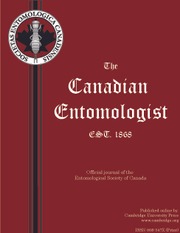No CrossRef data available.
Article contents
Occurrence and effectiveness of native and managed pollinators for haskap, Lonicera caerulea Linnaeus (Caprifoliceae), in southern Nova Scotia, Canada
Published online by Cambridge University Press: 18 November 2025
Abstract
Haskap, Lonicera caerulea Linnaeus (Caprifoliceae), is an emerging crop in Nova Scotia, Canada, that relies on cross-pollination for fruit production. In 2016 and 2017, we assessed the activity of honey bees, Apis mellifera Linnaeus (Hymenoptera: Apidae), in haskap orchards and compared this with native bumble bees, Bombus spp. (Hymenoptera: Apidae), while also documenting the early season wild bee community and potential of nesting boxes to support cavity-nesting bees. We found that haskap orchards in southern Nova Scotia support a diverse pollinator community. Andrena (Hymenoptera: Adrenidae) spp., A. mellifera, Bombus spp., and Lasioglossum spp. (Hymenoptera: Halictidae) comprised more than 75% of individuals captured in pan traps, but only A. mellifera and Bombus spp. were frequently observed on haskap blossoms. Honey bees and bumble bees deposited equal amounts of pollen on haskap stigmas, but bumble bees visited threefold more flowers per minute and visited both flowers of the haskap inflorescence more than twice as often as honey bees. Uptake of cavity-nesting bees into nesting boxes was relatively poor, and as many parasites (mostly Sapygidae) were collected from nesting boxes as bees. These results suggest honey bees and bumble bees are the best pollinators for haskap production in Nova Scotia.
Information
- Type
- Research Paper
- Information
- Copyright
- © The Author(s), 2025. Published by Cambridge University Press on behalf of Entomological Society of Canada
Footnotes
Subject editor: Shelley Hoover


